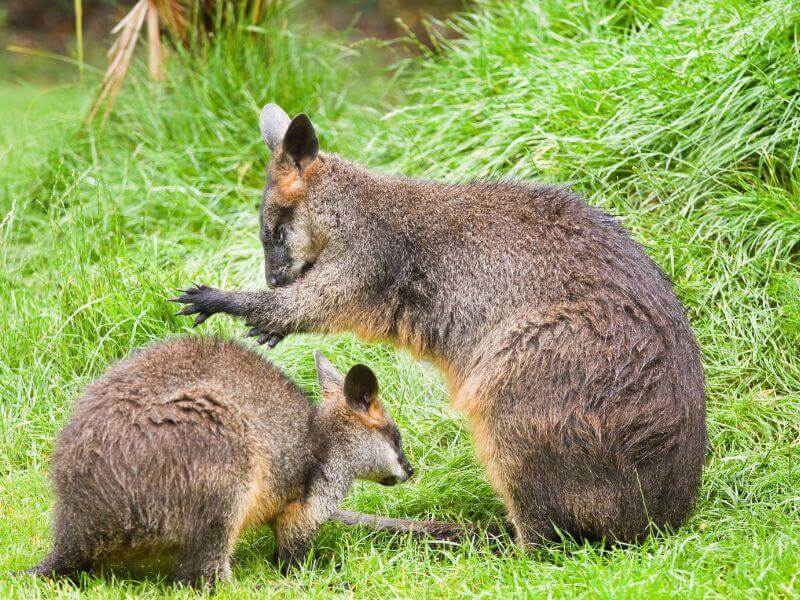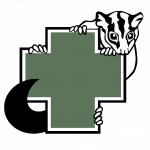RESCUE ADVICE
Kangaroos & Wallabies
Macropods is the family of mammals that kangaroos, wallabies, wallaroos and pademelons belong to. Kangaroos and wallabies thrive in various Australian habitats, but many species in NSW are endangered despite ongoing conservation efforts. They can run into trouble with cars, pets and illness.
They are mainly active in the early morning and late evening, spending the rest of the day resting. As herbivores, they primarily eat grass but also consume leaves, herbs, fruits, and flowers, needing minimal water. Kangaroos breed year-round. Newborn joeys, under 1 gram, enter the pouch on their own and stay there for 5 to 9 months. They begin to emerge but continue to suckle for 12 to 18 months. Females can mate again soon after giving birth, though the new embryo develops only after the previous joey leaves the pouch.
If you find an injured or sick echidna, please call our 24/7 Rescue Line on 0418 628 483. It is operated by volunteers at WIRES. They will alert our team and a trained rescuer will be out as soon as possible.
Rescue Advice
Macropods can be extremely dangerous, especially when injured! If you come across an injured kangaroo or wallaby please don’t approach it. Call our 24/7 Rescue Line on 0418 628 483 immediately and one of our rescuers will assist as soon as possible.
If you can, please stay in the area and keep your eyes on the animal until we arrive as they can only be rescued if we can locate them. If you have to leave, mark the area with a bag, some cloth – anything you have on hand helps! Try taking some photos of the area to send to our phone operators or mark the spot on your phone by “dropping a pin”.
If you have found a deceased female please check for a joey by gently opening the pouch (see Pouch Checking Guide). If a joey is in the pouch, please do not remove it. Contact our 24/7 Rescue Line on 0418 628 483 if you haven’t already done so.
Check the surrounds. Joeys can also be been bumped out of the pouch, or hiding in nearby bushes. Scan the area for movement and if you find a joey, call the hotline for advice.
Joeys
- If the operator advises you to contain the joey, please keep it in a warm, dark, quiet place to reduce stress e.g. wrapped in a towel or sheet in a ventilated carrier while you transport it to the nearest vet or wait for a rescuer.
- If you go directly to the vet, please let the Rescue Line know which vet you have taken the joey to.
- Cover with a towel to create a warm environment, and reduces visual stimuli. This means no nursing or cuddling; no photos; keeping it away from the TV, pet dog etc.
- If cold or has no fur, place a hot water bottle (even a drink bottle will do) filled with hot tap water only, wrapped in cloth, next to (never underneath) the joey.
Macropods in the Hunter region

Kangaroos
Eastern Grey Kangaroos can be found grazing in open areas at dusk and dawn around the Hunter region, surrounded by large, multi-generational mobs within which they form undeniable family bonds. Orphaned ‘easties’ are known to be big sooks, remaining ‘babies’ until they’re well over 10kg. Eastern greys are particularly susceptible to stress related illness, so if you pick up a joey, keeping them in a warm, dark and quiet environment is often life-saving.

Wallabies
We have Red-necked and Swamp Wallabies in the Hunter region. They are much more compact than any kangaroo. Swamp wallabies are usually solitary and relatively shy and secretive living in denser bushland and rainforest understorey. They’re fast and agile and gain independence very quickly.
Red-necked Wallabies are one of the cheekiest species in the macropod world. In care, they are pure mischief and are experts at sniffing out trouble. In the wild, these wallabies may hang out in loose groups of a few individuals, but don’t form “mobs” like eastern greys.

Common Wallaroo
Wallaroos look a bit like eastern grey kangaroos, but are stockier with course, shaggy fur. To the trained eye, they are easily recognisable by their nose (rhinarium) that is bare and black.
While in care, we often refer to wallaroos as “wallies”, and they have a reputation for being extreme escape artists and parkour enthusiasts.

Red-necked Pademelon
Pademelons look a bit like rednecked wallabies if you put them in the dryer for too long. They are another shy, solitary species that forage day and night in dense understorey.
Locally in the Hunter, pademelons can be found in the vicinities of Barrington Tops National Park and Watagans National Park.
Living around macropods
The most common reasons we are called for macropod rescues is they have been hit by a car, attacked by dogs and other pets and entangled in wire fencing. Some ways we can help improve their chances of staying safe:
- Never feed a wild animal. Kangaroos and wallabies have ample food sources and don’t need much water. Kangaroos and wallabies that are used to being fed can approach people expecting food. When there is no food, they may become aggressive.
- Slow down and be aware when you see a kangaroo road sign, particularly around dawn and dusk when they are most active.
- Keep dogs on a leash when walking through an area known to be inhabited by kangaroos or wallabies.
- Choose wildlife-friendly fencing. Avoid barbed wire and consider whether a row of native trees could suffice.
